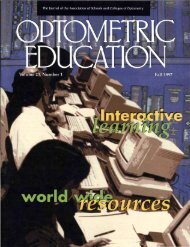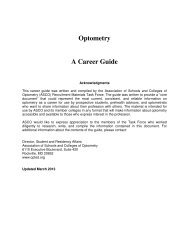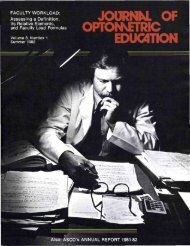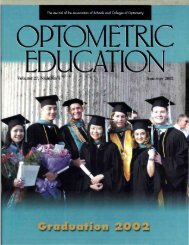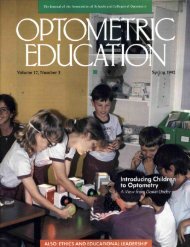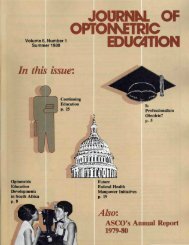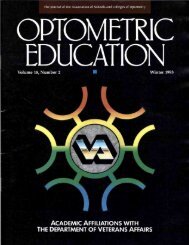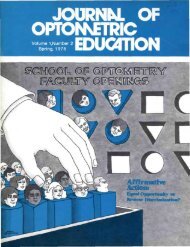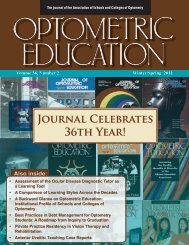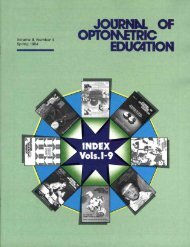Winter 1992, Volume 17, Number 2 - Association of Schools and ...
Winter 1992, Volume 17, Number 2 - Association of Schools and ...
Winter 1992, Volume 17, Number 2 - Association of Schools and ...
Create successful ePaper yourself
Turn your PDF publications into a flip-book with our unique Google optimized e-Paper software.
Continuing<br />
Education Needs <strong>of</strong><br />
Ohio Optometrists<br />
A Comparison with Other<br />
Health Care Providers<br />
Alan Escovitz, Ph.D.<br />
Arol Augsburger, O.D., M.S.<br />
Abstract<br />
An intenlisciplimry survey <strong>of</strong><br />
777/> Ohio health care provider* in<br />
five different disciplines including<br />
optometry is ilescribed. Key issues for<br />
planning continuing education programs<br />
uvre surveyed <strong>and</strong> arc reported.<br />
These results provide a framework<br />
for program development <strong>and</strong><br />
design <strong>of</strong> individual <strong>and</strong> interdisciplinary<br />
continuing pr<strong>of</strong>essional educational<br />
experiences in the health sciences.<br />
The study slunocd that program<br />
content, date, lime <strong>and</strong> location<br />
are the most important factors influencing<br />
program attendance. General<br />
optometric educators will he interested<br />
in the comparisons <strong>of</strong> opinions<br />
<strong>of</strong> optometrists <strong>and</strong> other health<br />
care providers toward continuing<br />
education.<br />
Key Words<br />
Continuing Education, Interdisciplinary,<br />
Needs Assessment,<br />
Planning<br />
Introduction<br />
The pr<strong>of</strong>ession <strong>of</strong> optometry has<br />
been a leader in the movement to formalize<br />
continuing education through<br />
m<strong>and</strong>atory participation related to<br />
license renewal. The assumption has<br />
been that through this vehicle, practitioners<br />
can keep abreast <strong>of</strong> scientific,<br />
technological, clinical patient care,<br />
<strong>and</strong> social changes affecting their<br />
practices, <strong>and</strong> can actively participate<br />
in these changes. The argument for<br />
this worthwhile purpose has been so<br />
persuasive that virtually all states<br />
have enacted m<strong>and</strong>atory continuing<br />
education requirements. In Ohio, the<br />
State Board <strong>of</strong> Optometry has required<br />
continuing education for<br />
nearly twenty years. Optometry was<br />
Dr. Escovitz is executive director <strong>of</strong> the Council <strong>of</strong><br />
Ohio Colleges <strong>of</strong> Pharmacy, the educational<br />
consortium <strong>of</strong> four Ohio pharmacy colleges, <strong>and</strong><br />
director <strong>of</strong> the Center for Continuing Health Science<br />
Education at The Ohio State University.<br />
Dr. Augsburger is a pr<strong>of</strong>essor <strong>of</strong> clinical optometry<br />
<strong>and</strong> chairman <strong>of</strong> the continuing education committee<br />
at The Ohio State University College <strong>of</strong> Optometry.<br />
the first licensed health care pr<strong>of</strong>essional<br />
group in the state to actively<br />
lobby for m<strong>and</strong>atory continuing education<br />
legislation.<br />
After twenty years a further evaluation<br />
<strong>of</strong> the perception <strong>of</strong> optometrists<br />
with regard to continuing education<br />
would be timely. Do optometrists<br />
(or other health providers)<br />
choose to take continuing education<br />
because it is m<strong>and</strong>ated? Do other<br />
factors enter into the decision to take<br />
continuing education? Is optometry<br />
more or less similar to other health<br />
pr<strong>of</strong>essions in regard to opinions<br />
about continuing education? Are<br />
providers <strong>of</strong> continuing education<br />
addressing the perceived needs <strong>of</strong><br />
optometrists? What changes could be<br />
made to <strong>of</strong>fer even better continuing<br />
education to optometrists? The<br />
assessment <strong>of</strong> continuing education<br />
needs for individual health pr<strong>of</strong>essions<br />
has been previously reported 1 - 2<br />
but interdisciplinary assessment <strong>of</strong><br />
continuing education has rarely been<br />
addressed. 34 - 5<br />
To answer these questions a project<br />
was designed by the Advisory Committee<br />
for the Center for Continuing<br />
Health Sciences Education at the<br />
Ohio State University. Included in<br />
this committee were representatives<br />
from the College <strong>of</strong> Optometry, College<br />
<strong>of</strong> Pharmacy, College <strong>of</strong> Medicine,<br />
College <strong>of</strong> Nursing, Department<br />
<strong>of</strong> Nursing Staff Development OSU<br />
Hospitals, <strong>and</strong> the School <strong>of</strong> Allied<br />
Medicine. Specifically the project was<br />
designed to:<br />
1) identify the demographic characteristics<br />
<strong>of</strong> five health care groups<br />
(optometrists, physicians, pharmacists,<br />
nurses, <strong>and</strong> allied medicine personnel).<br />
2) define the past participation in<br />
continuing education.<br />
3) assess the preferred formats for<br />
obtaining continuing education.<br />
4) survey opinions related to current<br />
pr<strong>of</strong>essional issues.<br />
Methods<br />
The survey questionnaire designed<br />
by the Advisory Committee for the<br />
Center for Continuing Health Sciences<br />
Education was mailed to a<br />
r<strong>and</strong>om sample <strong>of</strong> 4692 Ohio health<br />
providers in the summer <strong>of</strong> 1989. The<br />
four page survey instrument is appended<br />
to this study. Table 1 summarizes<br />
the distribution <strong>of</strong> the 4692<br />
surveys which were mailed <strong>and</strong> the<br />
percent returned for each pr<strong>of</strong>essional<br />
group. Optometrists displayed<br />
<strong>Volume</strong> <strong>17</strong>, <strong>Number</strong> 2 I <strong>Winter</strong> 1991 41



